What are you to do when you’re a disembodied brain in a jar, whose henchman is a hyper violent imbecile with two hooks instead of hands, and the super computer running your operations to take over the world suddenly burns out one night? Obviously it’s time to call in some help from tech support to get your evil scheme back online, and then kill him afterwards as you’re way too cheap to pay the $25 he’s going to charge for the house call. Unfortunately for the evil Dr. Neuro Neurosis, the man he called in to fix his apocalyptic doomsday system – Lance Galahad – is not nearly as helpless as the floating brain first surmised.
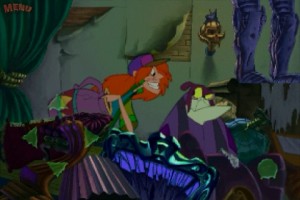 However, what Lance Galahad does not know is that standing between him and the floating brain will be – among other things – a sports addicted Frankenstein esque monster, a vampiric southern belle hair dresser, and the ever present Fritz himself! The always energetic Fritz is a particularly violent – as well as extremely dimwitted – henchman that can only best be described as akin to a force of nature, and the inside of his coat seems to be a pocket dimension for storing all sorts of highly improbable weaponry. No matter where Lance goes – no matter how clever he is – Fritz will always be there just a few steps behind him, ready to enact all sorts of comically macabre horrors upon the hero the second he slips up.
However, what Lance Galahad does not know is that standing between him and the floating brain will be – among other things – a sports addicted Frankenstein esque monster, a vampiric southern belle hair dresser, and the ever present Fritz himself! The always energetic Fritz is a particularly violent – as well as extremely dimwitted – henchman that can only best be described as akin to a force of nature, and the inside of his coat seems to be a pocket dimension for storing all sorts of highly improbable weaponry. No matter where Lance goes – no matter how clever he is – Fritz will always be there just a few steps behind him, ready to enact all sorts of comically macabre horrors upon the hero the second he slips up.
Digital Leisure’s Brain Dead 13 (out now, $4.99) is a port of a somewhat obscure FMV game, originally released all the way back in 1995, that strived as hard as it could to invoke the spirit of Don Bluth’s legendary Dragon’s Lair. Well – to be honest – it doesn’t quite reach that lofty goal, and it is indeed a lofty goal when you aim your sights for a game that is a permanent display piece in the Smithsonian itself. That said – especially thanks to some very helpful changes in this recent port – there’s still a lot of fun to be had in this game, although it’s certainly not going to change the mind of anyone who didn’t like Dragon’s Lair to begin with.
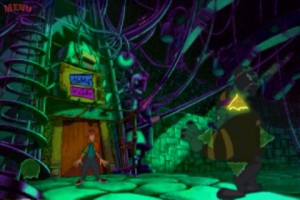 Much like Dragon’s Lair before it, Brain Dead 13 controls by having you choosing one of five possible inputs at the right time to avoid some sort of incoming danger that seeks to stop Lance from putting the kibosh on the not-so-good doctor’s plans. There are options in the game’s settings menu to flop the controls for left handed people, as well as an option to control the size of the buttons comprising the virtual on screen controls. Even though it will cause the semi-transparent buttons to obscure more of the game’s animation, I heavily suggest cranking the size of the buttons up from small to medium so that you won’t accrue accidental deaths just because you had trouble hitting the buttons.
Much like Dragon’s Lair before it, Brain Dead 13 controls by having you choosing one of five possible inputs at the right time to avoid some sort of incoming danger that seeks to stop Lance from putting the kibosh on the not-so-good doctor’s plans. There are options in the game’s settings menu to flop the controls for left handed people, as well as an option to control the size of the buttons comprising the virtual on screen controls. Even though it will cause the semi-transparent buttons to obscure more of the game’s animation, I heavily suggest cranking the size of the buttons up from small to medium so that you won’t accrue accidental deaths just because you had trouble hitting the buttons.
Another option you can find in the game’s configuration menu, on by default, is to have the correct on screen button light up when it needs to be pressed. While you can turn this option off, I heavily recommend against doing that as you’re here to enjoy the animation rather than bludgeon your head into oblivion by way of frustration. One of the things that kept this game from being an all time classic back in the day was that, unlike Dragon’s Lair, there are times when Lance’s on screen actions don’t logically correlate to the button you need to press. Case in point: both up, down, and the action button are all used at different locations to have Lance duck out of an obstacle’s way.
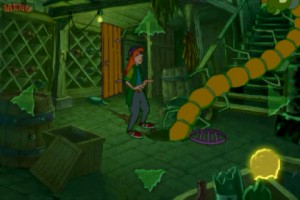 Another problem this game had back in the day when compared to Dragon’s Lair, and still does have, is that the buttons usually need to be pressed within an exceptionally narrow time frame. While Dragon’s Lair itself had some button commands that had to be pressed with split second timing, they weren’t used for almost every single action in Don Bluth’s masterpiece. Figuring out the timing of the twitch based actions in Brain Dead 13 is another thing that has now been made infinitely less frustrating to accomplish with the iOS port’s helpful light up button feature.
Another problem this game had back in the day when compared to Dragon’s Lair, and still does have, is that the buttons usually need to be pressed within an exceptionally narrow time frame. While Dragon’s Lair itself had some button commands that had to be pressed with split second timing, they weren’t used for almost every single action in Don Bluth’s masterpiece. Figuring out the timing of the twitch based actions in Brain Dead 13 is another thing that has now been made infinitely less frustrating to accomplish with the iOS port’s helpful light up button feature.
Unlike Dragon’s Lair, which was originally designed for arcades, Lance will never come face to face with a continue screen as he has an infinite number of lives to back up his quest against Neuro Neurosis. So every time Lance meets yet another gruesome demise at the hands of the castle’s bizarre inhabitants, there will be a context specific resurrection animation that shows Lance coming back into action. Furthermore, in a move that actually makes the game more playable than Don Bluth’s later FMV games, Brain Dead 13 features multiple checkpoints in the bigger areas so that a single death doesn’t force you to replay the longer sequences from scratch.
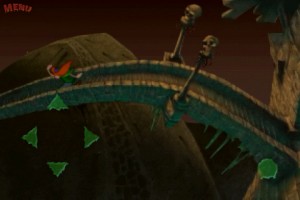 Another place where Brain Dead 13 deviates from Dragon’s Lair’s template, specifically in an interesting way, is that the game play here is not nearly as linear as in Don Bluth’s more famous title. While there are 5 sub bosses whom must be defeated before you can move on to the final set of showdowns, the order you meet them in is completely up to you. As you run about the castle you will find various times – particularly at hallway junctions – where multiple buttons will light up, each of them representing valid actions you can take. This does – however – also mean that one needs to actually strive to create a mental map of the inside of the castle, or they are just going to waste a lot of time running around in needless circles.
Another place where Brain Dead 13 deviates from Dragon’s Lair’s template, specifically in an interesting way, is that the game play here is not nearly as linear as in Don Bluth’s more famous title. While there are 5 sub bosses whom must be defeated before you can move on to the final set of showdowns, the order you meet them in is completely up to you. As you run about the castle you will find various times – particularly at hallway junctions – where multiple buttons will light up, each of them representing valid actions you can take. This does – however – also mean that one needs to actually strive to create a mental map of the inside of the castle, or they are just going to waste a lot of time running around in needless circles.
There are also lengthy segments in Brain Dead 13 where the player doesn’t have to input any buttons at all, such as the game’s introduction sequence that runs for nearly seven minutes long. This is in direct contrast to Dragon’s Lair where no set up – save for the narrator’s attract mode speech – is ever given for why anything is happening, and almost no time is ever spent that is not part of the actual game play. This difference, which also originates from the fact that Brain Dead 13 was never an arcade title to begin with, does end up giving it a more cohesive sense of narrative than its more famous cousin.
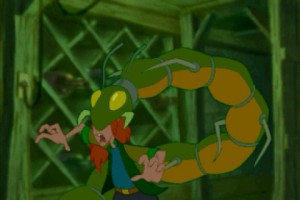 Anyways, with the controls and game mechanics out of the way, I now want to talk about the entire reason for Brain Dead 13’s existence: the hand drawn animation. The animation of Brain Dead 13 would be considered very fluid if it was being made for television, and is all drawn in an extremely cartoony Saturday morning style. Unfortunately, the animation in this game does not takes advantage of the iPod’s Retina display – nor is the game available on the iPad at all – probably because the only master source that still exists for Brain Dead 13’s animation is the original 1995 CD that the game was first released on.
Anyways, with the controls and game mechanics out of the way, I now want to talk about the entire reason for Brain Dead 13’s existence: the hand drawn animation. The animation of Brain Dead 13 would be considered very fluid if it was being made for television, and is all drawn in an extremely cartoony Saturday morning style. Unfortunately, the animation in this game does not takes advantage of the iPod’s Retina display – nor is the game available on the iPad at all – probably because the only master source that still exists for Brain Dead 13’s animation is the original 1995 CD that the game was first released on.
In particular, the game’s Saturday morning cartoon style presentation is very important since whenever Lance meets his demise – which will happen often – his end will be something rather dark and gruesome. However, thanks to the visual style, it’s all presented in such an over-the-top whimsical fashion that you will sometimes find yourself just standing at random hallway junctions – each of which have their own unique death sequence – just so that Fritz can catch up and show you what creative way he will dispose of Lance next. I am being entirely serious when I tell you that there is one specific hallway junction where, if you wait long enough, Lance will suddenly double over in pain before Fritz inexplicably bursts out from his stomach in some sort of homage to the Alien films.
iFanzine Verdict: If you liked other FMV games available on the iOS devices – such as Don Bluth’s legendary Dragon’s Lair – then this recent release of Brain Dead 13 should definitely be checked out, especially with the changes that make this port more playable than the original release. Its whimsically over-the-top take on an otherwise macabre series of events – and especially anything involving Fritz in general – are all very amusing to watch, and easily well worth the asked price tag. However, if you didn’t like Dragon’s Lair at all – or did, but found that it was at the upper limits of what you were willing tolerate in regards to frustration – then you should probably just pass on this.

